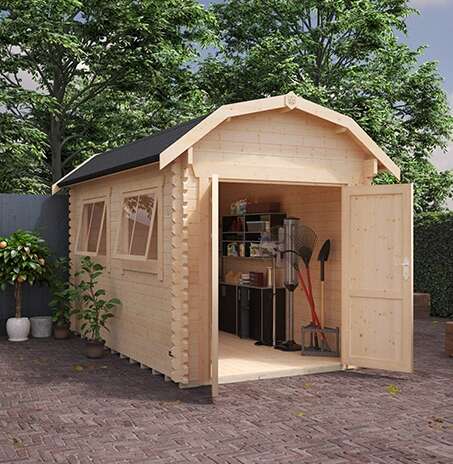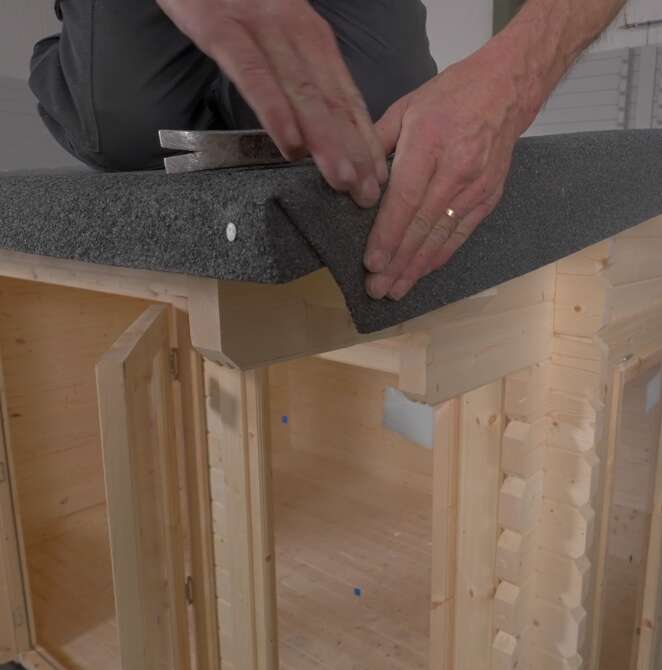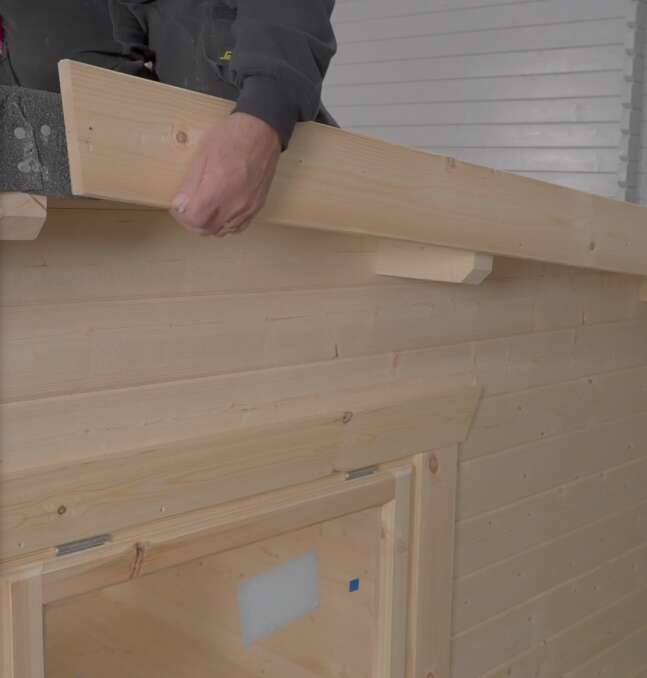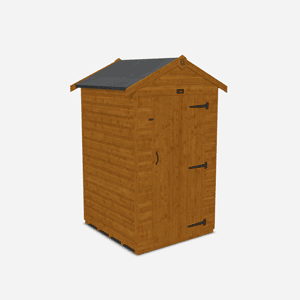Protect your Garden room from Climate Change
Published: 13/02/2023

As the UK announced 2022 as it’s hottest year to date with a high of 40 degrees Celsius and low of -17 degrees*, there is lots to discuss about protecting timber garden rooms from the flitting temperature highs and lows caused by ongoing climate change.
From icy evenings to milder mornings, we are becoming accustomed to temperamental temperatures but how equipped are our garden buildings for dealing with the everchanging weather?
With 40,000 Google searches last month alone, garden rooms are set to be big in 2023 so we thought it would be useful to explain the effects of rapidly changing weather on trending wooden garden buildings and tips to protect them moving forward.
Regular climactic changes of recent years can lead to variations of moisture levels in the air. Wood naturally soaks in more moisture when the air is milder and more humid and will release excess moisture when it’s cool and less humid.
The type of garden building you choose can make all the difference when wanting to protect against the everchanging temperatures, so here are the key things to be mindful of to continue enjoying your outdoor spaces all year round.
Wood Quality is Paramount
Choosing the right timber for your building is the first step in increasing its longevity. Timbers that are slow grown over a longer period will have a tighter grain and naturally will be more airtight to block out moisture from varying levels of humidity which means your garden building will be likely to last a lot longer when experiencing climate changes.

Tiger Shiplap Pent Shed | Wooden Shiplap Sheds | Tiger Sheds feature a unique cladding system that interlocks to let water and damp roll off the surface onto the floor. This fantastic cladding system also prevents cold air and drafts from flowing into the building.
Choose heavy duty framing to make your building stronger to give it the strength to last against high winds. Beware of sheds that use rough sawn ‘matchstick thin’ framework that barely hold the building together.
Tiger garden buildings come with an industry leading 20-year guarantee because we are so confident with the quality of our products.
Build on a Raised Base
With the ground likely to soak up any extra moisture, it’s best to build any garden building on a raised base but always remember to check that it is firm and level before starting any building work. We’d recommend a concrete base or a plastic EcoBase to help to protect from excess moisture in the soft ground that could penetrate the bottom piece of cladding. If you choose a slab base, it’s a good ideal to leave small gaps between slabs to let the air circulate underneath the building.

Fastfit Standard Shed Base | Tiger Sheds
Preserving & Sealing Your Garden Room is Vital
Garden room maintenance is unavoidable, but sealing wood is one of the most important and easiest ways to protect it from water or moisture damage and fluctuating temperatures. Use a quality shed paint and shed preservative and you’ll get the job done in no time. Prefer a natural wooden finish to your shed, log cabin or summerhouse? Then TigerSkin® Clear Wood Protector treatment is perfect. It’s easy to apply and could help extend your shed’s life beyond the 20-year Tiger guarantee.
Wood paints and preservers are essential to maintain the surfaces of a wooden structure and prevent moisture from penetrating the wood and therefore reducing the risk of any potential swelling or shrinking of the cladding. Popular preservatives include polyurethane, oil based varnishes and shed paints. Remember to seal wooden structures regularly to keep on top of timber maintenance and protection all year round.

Ventilate & Insulate your Garden Room
Keeping an airflow running through the garden room will help to regulate the moisture taken in by and released from the timber to avoid build ups in more airtight buildings. If possible, when using your space keep the door propped slightly open for further ventilation and moisture management and consider leaving at least a one metre perimeter between your building and fences for allow air flow around the outside too and room for that all important maintenance. For more ventilation advice read this ‘How to Ventilate your Shed or Log Cabin’ guide.

The Alpha Barn | 28mm Log Cabin | Tiger Sheds has opening windows and double doors for greater ventilation.
Insulation will keep your building cool in Summer and warmer in Winter, so it’s a good way to achieve the best thermal performance throughout the year. Space saving SuperFOIL Shed Insulation is great for installation on internal shed walls and the roof. It’s a great 3 in 1 solution because it provides you with thermal insulation, a radiant barrier and a vapour control layer.
If you have a north facing garden or want to protect your garden building against the cold, position your building for maximum sun exposure and paint walls dark as it will reflect less solar heat.

Tiger Potting Sheds | Garden Potting Shed | Tiger Sheds
If you have a north facing garden then paint with lighter colours to reflect the heat.

Tiger Vista Corner Summerhouse |Corner Summerhouses | Tiger Sheds | Tiger Sheds
Protect your Garden Building Roof
First, position your garden room away from any trees to avoid unnecessary damage and remove leaves from the roof as they will stop effective water drainage.
If you live in a particularly windy coastal area for example, it’s important to think about roof design as an angled roof stands better in strong winds. Sloped roof styles include apex, pent, hipex and barn.
Choosing quality roof felt and then installing roof shingles on top of the felt will give your garden room an extra layer of protection and adds to insulation.

Image: Roof shingles available in a choice of colours
Excessive amounts of snow or water turning to ice can put a lot of pressure on a shed roof, which in turn can lead to damage. Before a heavy rain shower or icy spell, check the roof for damage and make sure it is securely fastened. Test the roofs strain to make sure it can withstand extreme conditions. When it snows, use a brush and push the snow or ice onto the ground to make sure there isn't too much stress on the roof. Or if it looks worse due to wear and tear, it is worth replacing the roof felt.


Tiger Tip – Ensure high quality roof felt is tight and make sure fascia boards (barge boards) are secured over felt
Seal, not conceal!
As a starting point your garden room will need structural integrity. This means stable and strong framing and cladding.
Cheaper quality sheds, log cabins and summerhouses are likely to have thinner frames and poor, roughly finished, thinner cladding boards or timber logs. Tiger Shiplap Sheds are built with only the highest quality materials which many garden sheds on the market today cannot compare to, and tongue and groove cladding is better at stopping the wind and rain getting inside. Also consider the flooring, as cheaper sheds can use OSB (orientated strand board) to keep the price down, but the cons of OSB is that the sheets swell up when exposed to water and damp conditions.

Tongue & Groove Sheds | Wooden Tongue & Groove Garden Sheds | Tiger Sheds
One of the most common problems in wet weather is leaks and this can cause irreparable damage to a garden building such as rotting. Walk around the outside and inside to inspect for holes or openings in doors and windows. Make sure all openings are watertight and if not, reseal them before it's too late.
Now that you’ve read the above, here’s our top Tiger Tips in bitesize pieces, of how you can protect your garden building against the unpredictable British weather:
How to Protect your Shed from Heavy Rain & Snow
- Choose a roof with a slight pitch such as an apex, pent, hipex or barn style
- Use quality, strong roof felt and add roof shingles on top for extra protection
- Elevate the garden building from off ground
- When it snows, use a brush and push the snow or ice onto the ground to make sure there isn't too much stress on the roof
- Invest in high quality tongue and groove cladding. These boards connect together with a tongue in one panel, and a groove on the next. The tongue slots into the groove, creating a seamless and sleek look that’s both attractive and effective at keeping out any bad weather that might sweep through your garden
- Fit and seal your windows properly – here’s a helpful guide
- Treat your wood with special wood paints or preservers as regularly as you can to protect it from the elements
- Fit some effective guttering – collect water in tanks for keeping garden hydrated
- Regularly check to make sure your garden room is watertight and if not, repair any holes
How to Protect your Shed from Extreme Changing Temperatures
- Invest in the best wood cladding specification you can for your budget – the thicker and smoother the cladding the longer it will last
- Insulate to keep your garden room cooler in Summer and warmer in Winter
- Ventilate frequently for effective moisture management
- To keep your garden room warmer, position your building for maximum sun exposure and paint walls dark as it will reflect less solar heat
- To keep your garden room cooler, position your building in a sheltered spot and paint walls in light colours to reflect solar heat
- Use a quality wooden shed paint or preserver to protect the cladding
How to Protect your Shed from High Winds
- Invest in the best wood cladding specification possible for your budget: the thicker and smoother the cladding, the longer it will last
- Choose heavy duty framing to protect against high winds
- Place your garden building away from any trees to avoid damage by falling branches
- Pitched roofs fair better in high winds so consider this before you buy
- Choose a quality, strong roof felt and install roof shingles over the felt for extra protection
- Periodically check the roof for damage and make sure the felt is securely fastened
- Test the roofs strain to make sure it can withstand extreme conditions
Located in the heart of Yorkshire, Tiger is one of the UK’s leading garden building specialists and has a growing collection of sheds, summerhouses and log cabins. A family-owned business with over 100 years of heritage, Tiger is renowned for providing excellent quality products and offering unprecedented levels of service.









